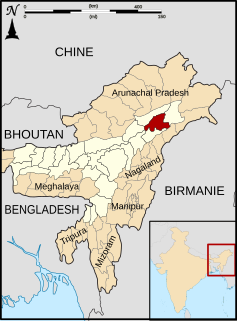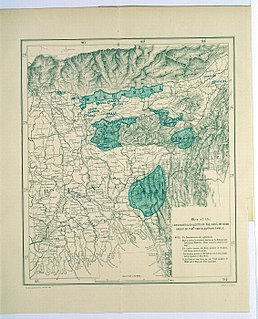Related Research Articles

Assam is a state in northeastern India, situated south of the eastern Himalayas along the Brahmaputra and Barak River valleys. Assam covers an area of 78,438 km2 (30,285 sq mi). The state is bordered by Bhutan and Arunachal Pradesh to the north; Nagaland and Manipur to the east; Meghalaya, Tripura, Mizoram and Bangladesh to the south; and West Bengal to the west via the Siliguri Corridor, a 22 kilometres (14 mi) wide strip of land that connects the state to the rest of India. It is also one of the world's most populous subdivisions. Assamese is the official and most common language, followed by Bengali, the second most common.

Bihu is a set of three important Assamese festivals in the Indian state of Assam—Rongali or Bohag Bihu observed in April, Kongali or Kati Bihu observed in October, and Bhogali or Magh Bihu observed in January. The Rongali Bihu is the most important of the three, celebrating spring festival. The Bhogali Bihu or the Magh Bihu is a harvest festival, with community feasts. The Kongali Bihu or the Kati Bihu is the sombre, thrifty one reflecting a season of short supplies and is an animistic festival.

The Ahom, or Tai-Ahom is an ethnic group from the Indian states of Assam and Arunachal Pradesh. They are the admixed descendants of the Tai people who reached the Brahmaputra valley of Assam in 1228 and the local indigenous people who joined them over the course of history. Sukaphaa, the leader of the Tai group and his 9000 followers established the Ahom kingdom, which controlled much of the Brahmaputra Valley in modern Assam until 1826.

Dibrugarh (Pron:ˌdɪbru:ˈgor:) is an administrative district in the state of Assam in India. The district headquarters are located at Dibrugarh city. The district occupies an area of 3381 km².

The Dimasa Kingdom was a major kingdom in Assam, Northeast India ruled by Dimasa kings, called Timisa in the Ahom Buranjis. The Dimasa kingdom and others that developed in the wake of the Kamarupa kingdom were examples of new states that emerged from indigenous communities in Medieval Assam that transformed these communities. The British finally annexed the kingdom: the plains in 1832 and the hills in 1834. This kingdom gave its name to undivided Cachar district of colonial Assam. And after independence the undivided Cachar district was split into three districts in Assam: Dima Hasao district, Cachar district, Hailakandi district. The kingdom finds mention in Chinese chronicles.

Bodo-Kachari is a generic term applied to a number of ethnic groups living predominantly in the Northeast Indian states of Assam, Tripura & Meghalaya, that speaks Assamese and Boro-Garo languages, some of who possibly have shared ancestries. Many of these peoples formed early states in the late Medieval era of Indian history and which came under varying degrees of Sanskritisation.

The people of Assam inhabit a multi-ethnic, multi-linguistic and multi-religious society. They speak languages that belong to three main language groups: Tibeto-Burman, Indo-Aryan, and Tai-Kadai. The large number of ethnic and linguistic groups, the population composition, and the peopling process in the state has led to it being called an "India in miniature".
Habung is an expansive fortification region in between Pachim Dhemaji and Dhakuakhana under undivided Dhemaji district in bank of Korha and Charikodiya rivers in Assam. Habung (Ha-vrnga-Vishaya) was a place where Brahmins brought from other parts were settled by Ratna Pala of the Pala dynasty of Kamarupa in the 10th century.

The culture of Assam is traditionally a hybrid one, developed due to cultural assimilation of different ethno-cultural groups under various political-economic systems in different periods of history.

Kachari is a Sino-Tibetan language of the Boro-Garo supgroup, spoken in Assam, India. With fewer than 60,000 speakers recorded in 1997, and the Asam 2001 Census reporting a literacy rate of 81% the Kachari language is currently ranked as threatened. Kachari is closely related to surrounding languages, including Tiwa, Rābhā, Hajong, Kochi and Mechi.
The Dhimal or Dhemal are an ethnic group residing in the eastern Terai of Nepal. They are a Sino-Tibetan-speaking ethnic group of the eastern Terai. They mainly reside in Morang and Jhapa districts of Nepal and Darjeeling district of West Bengal, India. Several scholars both in India and Nepal have referred to Dhimals as a 'forgotten ethnic group'. They are scions of the Bodo-Kachari lineage, which includes Bodos, Dimasas, Tiprasas, Rabhas, Tiwas, Sonowals and many others. They are respected as the "First Citizens" of Damak municipality.
Khamyang is a critically endangered Tai language of India, spoken by the Khamyang people. Approximately fifty people speak the language; all reside in the village of Powaimukh, located seven miles downstream of Margherita in the Tinsukia district. It is closely related to the other Tai languages in the Assam region: Aiton, Khamti, Phake, and Turung.

Magh Bihu (also called Bhogali Bihu or Maghar Domahi is a harvest festival celebrated in Assam, North-East India, which marks the end of harvesting season in the month of Magh. .A bonfire is lit for the ceremonial conclusion and prayer to the God of Fire. The festival is developed by the Tibeto-Burman, Austroasiatic and Indo-aryan cultures and festivals Magan of Kachari. The Festival has maximum indigenous Tribal Asian i.e. Sino-Tibetan and Austroasiatic and a bit of Indo-European essence due to variation of the Tribes found in Assam.

The Chutia Kingdom (1187–1523) was a late medieval state that developed around Sadiya in Assam and adjoining areas in Arunachal Pradesh. It extended over almost the entire region of present districts of Lakhimpur, Dhemaji, Tinsukia and some parts of Dibrugarh. The kingdom fell in 1523 to the Ahom Kingdom after a series of conflicts and the area ruled by the Chutia rulers became the administrative domain of the office of Sadia Khowa Gohain of the Ahom kingdom.
The Boro–Garo languages are a branch of Sino-Tibetan languages, spoken primarily in Northeast India and parts of Bangladesh.
Tiwa (Lalung) is an ethnic group mainly inhabiting the states of Assam and Meghalaya in northeastern India. They are also found in some areas of Arunachal Pradesh, Manipur and Nagaland. They are recognized as a Scheduled tribe within the State of Assam. They were known as Lalungs in the Assamese Buranjis, Colonial literature and in the Constitution of India, though members of the group prefer to call themselves Tiwa. Some of their neighbors still call them Lalung.
Moran (Morān) is an extinct Boro-Garo language which was spoken in Assam in Northeast India and related to Dimasa language. The census returned 78 speakers in 1901, 24 in 1911 and none in 1931, and the only source of this language exists in a 1904 article by P R Gurdon. The speakers of this language have shifted to the Assamese language. The name "Moran" reportedly means 'forest dweller'.

The Chutia people are an ethnic group originating in the Indian state of Assam. They are part of the Kachari group. The Chutia people, through the Chutia dynasty, formed their kingdom in the present Indian states of Assam and Arunachal Pradesh and reigned from 1187 to 1673.
The Kirāta, Kiranti or Kirati is a generic term in Sanskrit literature for people who lived in the mountains, particularly in the Himalayas, North-East India and who are postulated to have been Mongoloid in origin. Limbu, Yakkha, Sunuwar, Rai, Lepcha, Dhimal, are the major tribes of Kirati community.

Muga silk is a variety of wild silk geographically tagged to the state of Assam in India. The silk is known for its extreme durability and has a natural yellowish-golden tint with a shimmering, glossy texture. It was previously reserved for the use of royalty.
References
- ↑ "Virtually all of Assam’s kings, from the fourth-century Varmans down to the eighteenth-century Ahoms, came from non-Aryan Tibeto-Burman tribes that were only gradually Sanskritised." ( Urban 2011 , p. 234)
- ↑ "Virtually all of Assam’s kings, from the fourth-century Varmans down to the eighteenth-century Ahoms, came from non-Aryan tribes that were only gradually Sanskritised." ( Urban 2011 , p. 234)